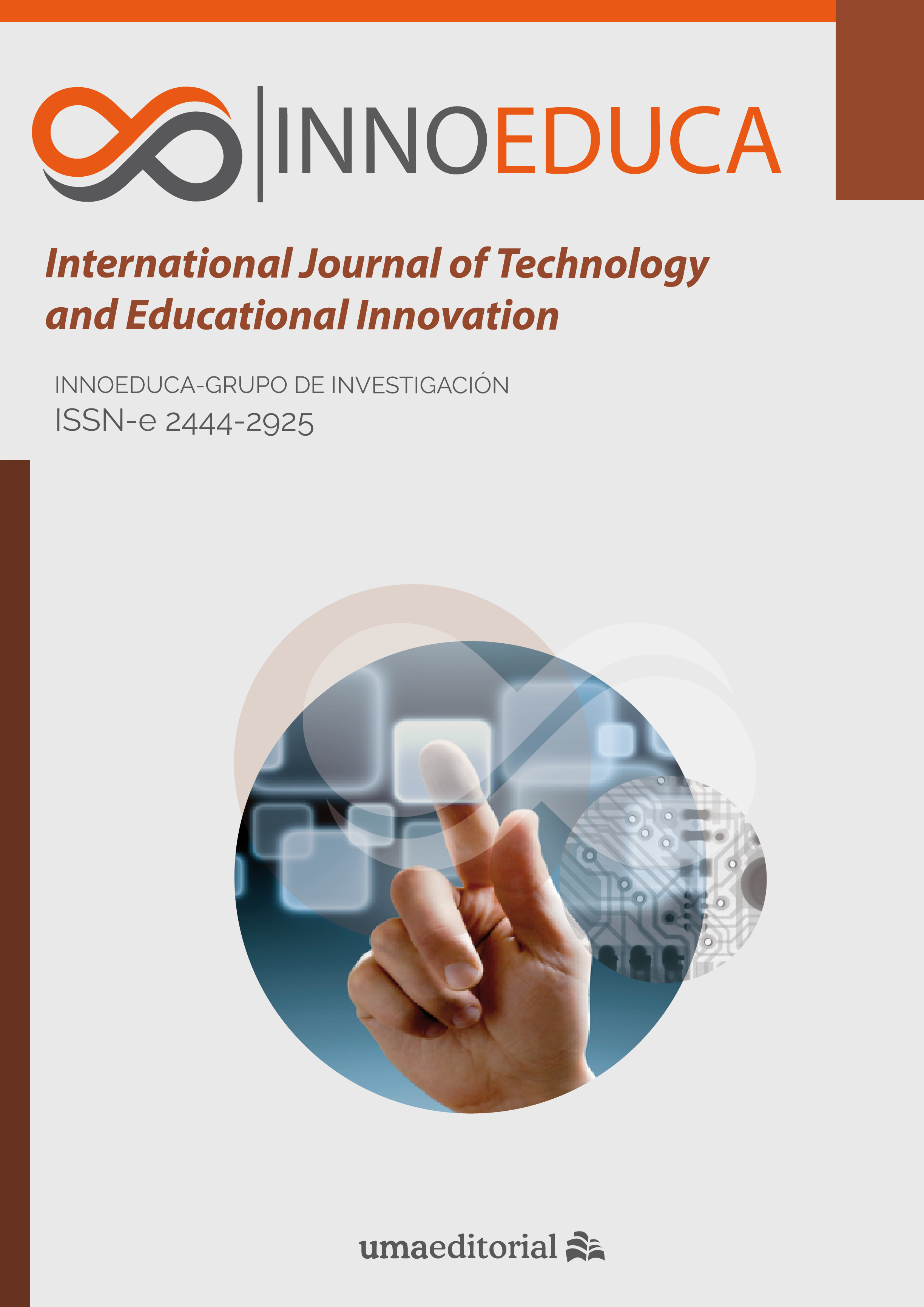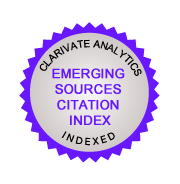Analysis of the state of the art on the use of video games in Nursery and Primary Education
DOI:
https://doi.org/10.24310/innoeduca.2021.v7i2.11541Keywords:
childhood, technology, video games, educationAbstract
The integration of technologies in the educational field is an undeniable reality in the 21st century society, characterized by the rapid changes that make the educational revolution and innovation possible. Proof of this is the use of video games in schools in the Infant and Primary Education stages. These gamified practices through technology are not exempt from criticism or sensitivity about their educational possibilities. In order to describe the benefits and possibilities of the introduction of video games in classrooms detected in the scientific literature, a literature review study has been carried out. For this, the Scopus, WOS, ERIC and Dialnet databases were used, and a total of 18 documents were selected for analysis using the PRISMA method. The results show that video games can contribute positively to teaching-learning processes, develop cognitive and creative aspects, and even improve some social attitudes. In short, this study demonstrates the possibilities of the educational use of video games with students of Nursery and Primary Education, as long as there are digitally trained and competent teachers, and the selection of the resource is made considering the pedagogical dimension, in addition to the technique.
Downloads
Metrics
References
Al Saud, A. F. (2017). Educational Video Games Enrich Underprivileged Children’s Social Skills in Saudi Arabia. European Journal of Educational Sciences, 4(2), 32-47. http://dx.doi.org/10.19044/ejes.v4no2a3
Antequera, J. A., Guerra, J., Teixeira, M. R., Costa, J. M., & del Águila, Y. (2019). Estudio de la orientación y la percepción espacial en alumnado del Grado de Educación Infantil a través del portal 2. Revista INFAD de Psicología. International Journal of Developmental and Educational Psychology, 3(1), 563-576. https://doi.org/10.17060/ijodaep.2019.n1.v3.1536
Anyaegbu, R., Ting, W., & Li, Y., (2012). Serious game motivation in an EFL classroom in Chinese primary school. TOJET: The Turkish Online Journal of Educational Technology, 11(1), 154-164.
Area, M., & González, C. (2015). De la enseñanza con libros de texto al aprendizaje en espacios online gamificados. Educatio Siglo XXI, 33(3), 15-38. http://dx.doi.org/10.6018/j/240791
Baños, R. M., Cebolla, A., Oliver, E., Alcañiz, M., & Botella, C. (2013). Efficacy and acceptability of an Internet platform to improve the learning of nutritional knowledge in children: the ETIOBE mates. Health education research, 28(2), 234-248. https://doi.org/10.1093/her/cys044
Barreto, D., Vasconcelos, L., & Orey, M. (2017). Motivation and learning engagement through playing math video games. Malaysian Journal of Learning and Instruction, 14(2), 1-21.
Castro, Á. P., Raposo-Rivas, M., & Martínez-Figueira, M. (2018). ¿Mejorar la atención con videojuegos? un estudio de caso. REOP-Revista Española de Orientación y Psicopedagogía, 29(3), 94-109. https://doi.org/10.5944/reop.vol.29.num.3.2018.23323
Cela, J. M., Esteve, F. M., Esteve, V., & Gisbert, M. (2014). Developing self-management and teamwork using digital games in 3D simulations. Australasian Journal of Educational Technology, 30(6), 634-651. https://doi.org/doi:10.14742/ajet.754
Checa-Romero, M. (2016). Developing skills in digital contexts: Video games and films as learning tools at primary school. Games and Culture, 11(5), 463-488. https://doi.org/10.1177/1555412015569248
Collins, A., & Halverson, R. (2014). La seconda rivoluzione educativa: come la tecnologia sta trasformando l'educazione. Italian Journal of Educational Technology, 22(1), 4-10.
Corsi, D., Revuelta, F. I., & Pedrera, M. I. (2019). Adquisición de competencias emocionales mediante el desarrollo y uso de Serious Games en Educación Superior. Pixel-Bit: Revista de Medios y Educación, (56), 95-112. https://doi.org/10.12795/pixelbit.2019.i56.05
Esnaola, G. A. (2006). Claves culturales en la construcción del conocimiento: ¿qué enseñan los videojuegos? Alfagrama Ediciones.
Fernandez, A. J., & Luque, E. (2021). I Libro Blanco español de la I+ D+ iy Ciencia en videojuegos. UMA Editorial.
Galindo, H. (2019). Los videojuegos en el desarrollo multidisciplinar del currículo de Educación Primaria: el caso Minecraft. Pixel-Bit: Revista de Medios y Educación, (55), 57-73. https://doi.org/10.12795/pixelbit. 2019.i55.04
Garmen, P., Rodríguez, C., García-Redondo, P., & San Pedro, J. C. (2019). Multiple intelligences and video games: Assessment and intervention with TOI software. Comunicar. Media Education Research Journal, 27(1), 95-104. https://doi.org/10.3916/C58-2019-09
Giaconi, C., & Del Bianco, N. (2019). In azione: Prove di inclusione. FrancoAngeli.
González-Valero, G., Ubago-Jiménez, J. L., Zurita-Ortega, F., Chacón-Cuberos, R., Castro-Sánchez, M., & Puertas-Molero, P. (2018). Eating Habits and Lifestyles in Schoolchildren from Granada (Spain). A Pilot Study. Education Sciences, 8(4), 1-10. https://doi.org/10.3390/educsci8040216
Guerra, J., Pedrera, M. I., & Revuelta, F. I. (2018). Perception of teaching skills through emotions by the use of social theme video games. EDMETIC, 7(2), 57-77. https://doi.org/10.21071/edmetic.v7i2.10950
Hansbøl, M., & Meyer, B. (2011). Shifting ontologies of a serious game and its relationships with English education for beginners. E-learning and Digital Media, 8(3), 228-246.
Hawkins, R. D., Mendes, G. A., & Williams, J. M. (2019). The Development and Evaluation of ‘Farm Animal Welfare’: An Educational Computer Game for Children. Animals, 9(3), 1-17. https://doi.org/10.3390/ani9030091
Hervás-Gómez, C., Ballesteros-Regaña, C., & Corujo-Vélez, C. (2018). La robótica como estrategia didáctica para las aulas de Educación Primaria. Hekademos: revista educativa digital, (24), 30-40.
Holguin, J., Taxa, F., Flores, R., & Olaya, S. (2020). Proyectos educativos de gamificación por videojuegos: desarrollo del pensamiento numérico y razonamiento escolar en contextos vulnerables. EDMETIC, Revista de Educación Mediática y TIC, 9(1), 80-103 https://doi.org/10.21071/edmetic.v9i1.12222
Hurtado, A., Ramírez, V., Talavera, M., & Cantó, J. (2015). Aplicaciones educativas de los videojuegos: Una propuesta didáctica con Minecraft para el aula de ciencias. Revista Internacional de Aprendizaje y Cibersociedad, 19(1), 73–90.
Ibáñez, M.B., García, J.J., Galán, S., Maroto, D., Morillo, D., & Kloos, CD (2011). Diseño y implementación de un mundo virtual multiusuario 3D para el aprendizaje de idiomas. Tecnología y sociedad educativas, 14(4), 2–10.
Icart, M.T., & Canela, J. (1994). El artículo de revisión. Enfermería clínica, 4(4), 180-184.
Jenson, J., de Castell, S., Muehrer, R., & McLaughlin-Jenkins, E. (2016). Playing and Learning: An iPad Game Development & Implementation Case Study Jouer et apprendre: une étude de cas du développement et de la mise en œuvre d’un jeu sur iPad. Canadian Journal of Learning and Technology/La revue canadienne de l’apprentissage et de la technologie, 42(3). https://www.learntechlib.org/p/173433/
Jiménez-Morales, M., Montaña, M., & Medina-Bravo, P. (2020). Childhood use of mobile devices: Influence of mothers’ socio-educational level. Comunicar, 28(64), 21-28. https://doi.org/10.3916/C64-2020-02
Lobel, A., Engels, R. C., Stone, L. L., Burk, W. J., & Granic, I. (2017). Video gaming and children’s psychosocial wellbeing: A longitudinal study. Journal of youth and adolescence, 46(4), 884-897. https://doi.org/10.1007/s10964-017-0646-z
Lunn, J., Khalaf, M., Hussain, A. J., Al-Jumeily, D., Pich, A., & McCarthy, S. (2016). The use of serious gaming for open learning environments. Knowledge Management & E-Learning: An International Journal, 8(1), 39-54. https://doi.org/10.34105/j.kmel.2016.08.004
Marín, D., Esnaola, G. & Donato, D. (En prensa). Videojuegos y educación: análisis de tendencias en investigación. Revista Colombiana de Educación.
Martín, D. (2008). Psicomotricidad e intervención educativa. Ediciones Pirámide.
Martínez-González, J. S. (2020). Los videojuegos, una adicción para los adolescentes. Con-Ciencia Serrana Boletín Científico de la Escuela Preparatoria Ixtlahuaco, 2(3), 40-41.
Molina, N. P. (2005). ¿Qué es el estado del arte? Ciencia y Tecnología para la salud Visual y Ocular, 3(5), 73-75.
Papanastasiou, G., Drigas, A., & Skianis, C. (2017). Serious games in preschool and primary education: benefits and impacts on curriculum course syllabus. International Journal of Emerging Technologies in Learning, 12(01), 44-56. https://doi.org/10.3991/ijet. v12i01.6065
Puspitasari, C. (2017). A New Tool to Facilitate Learning Reading for Early Childhood. Malaysian Online Journal of Educational Technology, 5(3), 1-15.
Ramos, S., & Botella, A. M. (2015). Los videojuegos como herramientas de aprendizaje una experiencia de innovación con la ópera de Mozart. DEDICA: Revista de Educação e humanidades, 9, 161?171.
Ramos, S., & Botella, A. M. (2016). La integración del videojuego educativo con el folklore. Una propuesta de aplicación en Educación Primaria. Revista Electrónica Interuniversitaria De Formación Del Profesorado, 19(3), 115-121. https://doi.org/10.6018/reifop.19.3.267281
Ricoy, C., & Ameneiros, A. (2016). Preferencias, dedicación y problemáticas generadas por los videojuegos: Una perspectiva de género. Revista Complutense de Educación, 27(3), 1291-1308. https://doi.org/10.5209/rev_RCED.2016.v27.n3.48445
Sáez-López, J.M., & Domínguez-Garrido, C. (2014). Integración pedagógica de la aplicación minecraft edu en educación primaria: Un estudio de caso. Pixel-Bit. Revista de Medios y Educación, (45), 95-110. https://www.redalyc.org/articulo.oa?id=36831300007
Sousa, C., & Costa, C. (2018). Videogames as a learning tool: is game-based learning more effective? Revista Lusófona de Educação 40(40), 199-210. https://doi.org/10.24140/issn.1645-7250.rle40.13
Strawhacker, A., Bers, M., Verish, C., Sullivan, A., & Shaer, O. (2018). Enhancing children's interest and knowledge in bioengineering through an interactive videogame. Journal of Information Technology Education: Innovations in Practice, 17(1), 55-81. https://doi.org/10.28945/3976
Tazouti, Y., Boulaknadel, S., & Fakhri, Y. (2019). JeuTICE: An Arabic Serious Game to Enhance Mathematics Skills of Young Children. International Journal of Emerging Technologies in Learning (iJET), 14(22), 252-265. https://doi.org/10.3991/ijet.v14i22.11119
Torres-Toukoumidis, A., Romero-Rodriguez, L., Amor, M., & Bjork, S. (2016). Development of reading skills through video games: state of the art. OCNOS-Revista de estudios sobre la lectura, 15(2), 37-49. https://doi.org/10.18239/ocnos_2016.15.2.1124
Trinchero, R. (2002). Manuale di ricerca educativa. Franco Angeli.
Urrútia, G., & Bonfill, X. (2010). Declaración PRISMA: una propuesta para mejorar la publicación de revisiones sistemáticas y metaanálisis. Medicina clínica, 135(11), 507-511. https://doi.org/10.1016/j.medcli.2010.01.015
Vélez, O., & Galeano, M. E. (Eds.) (2002). Investigación cualitativa: estado del arte. Centro de Investigaciones Sociales y Humanas.
Viola, F., & Cassone, V. I. (2017). L'arte del coinvolgimento: emozioni e stimoli per cambiare il mondo. Hoepli editore.
Zhao, Z., & Linaza, J. L. (2015). Relevance of videogames en the learning and development of young children. Electronic Journal of Research in Educational Psychology, 13(2), 301-318. https://doi.org/10.14204/ejrep.36.14108
Downloads
Published
How to Cite
Issue
Section
License
All contents published by Innoeduca. International Journal of Technology and Educational Innovation are subject to Creative Commons Attribution-Nocomercial-NoDerivatives 4.0 International License, whose complete text can be consulted at https://creativecommons.org/licenses/by-nc-nd/4.0/legalcode. Thus, copying, distribution, public communication, derivative works and commercial use of content are permitted as of the aforementioned issue provided that the source and the author of the text are cited.
It is the responsibility of the authors to obtain the necessary permits for images that are subject to copyright.

This work is licensed under a Creative Commons Attribution-NonCommercial-NoDerivatives 4.0 International License.









1.jpg)



242.png)








